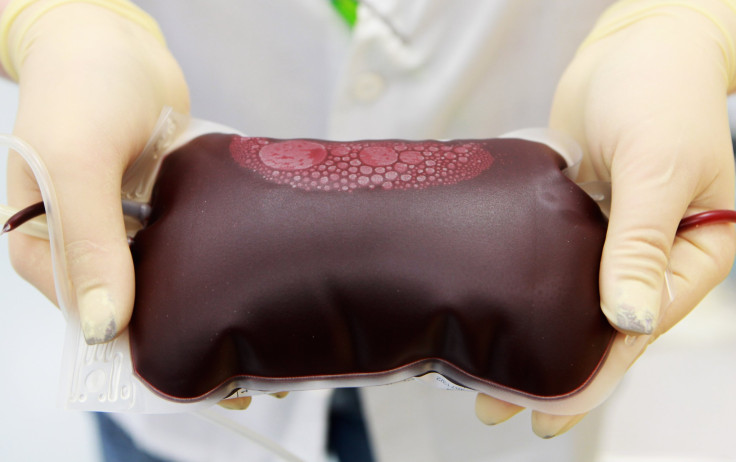Why Is AB Blood Type So Rare? It’s All About The Red Blood Cells

You’ve probably donated blood at least once in your life so, along with free apple juice, the American Red Cross gave you a card identifying your blood type. If you found out you're type AB, you're pretty unique, in fact, you have the rarest blood type of all. So why are so few people categorized as AB?
“We inherit our blood groups on genes,” Dr. Leslie Silberstein, a spokesperson for the American Society of Hematology and hematologist at Boston Children’s Hospital and Harvard Stem Cell Institute, told Medical Daily. “The blood group gene encodes for a protein that gets expressed on the surface of the red cell and that is what we detect in the laboratory. So what is expressed on the surface of the cell determines the type and which blood is compatible with which patient.”
Let’s take a step back to refresh the basics. All blood contains the same basic components: red cells, white cells, platelets, and plasma, which is the liquid portion of blood holding the red and white blood cells along with the platelets in suspension.
Red Blood Cells
Red blood cells, manufactured in the bone marrow, perform the hard work of carrying oxygen around the body. In every two to three drops of blood, roughly one billion blood cells reside. Red cells far outnumber both the platelets, which stop bleeding by clotting blood vessel injuries, and white cells, which protect your body from pathogens and disease. For every 600 red blood cells there are a mere 40 platelets and just one solitary white blood cell.
On the surface of the red blood cells, as Silberstein explained, are proteins with attached carbohydrates, essentially markers that identify the blood cells as our own. These microscopic markers, known as antigens, are commonly grouped in eight basic blood types: A, B, AB, and O, each of which can be either “positive” or “negative.”
“Blood group A means you have at least one blood group A gene and as a consequence your blood expresses an enzyme that attaches a distinct sugar to the protein or lipid on the red blood cell surface,” says Silberstein. “Blood group A has only A antigens.”
Similarly, blood group B has only B antigens, blood group AB has both, and blood group O has neither A nor B antigens on the surface of the red blood cells. These four groups are the most important because they indicate which blood type a patient can safely receive in a transfusion.
Patients receiving an incompatible blood type often experience a dangerous reaction; their immune system would recognize the unfamiliar antigen on the blood cell surface and attack. So if you were to give blood group A to a blood group B patient, their body would mount an immune response to destroy what it recognized as a foreign invader.
Meanwhile, your blood is either “positive,” meaning it contains the Rhesus D antigen, or “negative” meaning it lacks it. This is another inherited blood marker that also matters when it comes time for a transfusion.
Different blood groups are more and less common, with Stanford School of Medicine calculating the proportions in the general population as follows:
- O-positive: 37.4 percent
- O-negative: 6.6 percent
- A-positive: 35.7 percent
- A-negative: 6.3 percent
- B-positive: 8.5 percent
- B-negative: 1.5 percent
- AB-positive: 3.4 percent
- AB-negative: 0.6 percent
These are “ballpark percentages” Silberstein says, since they vary somewhat based on ethnic background. For example, blood group B is more prevalent in Asian individuals compared to Caucasians, while Group O is more common in Hispanics. Based on the population as a whole, though, these are the approximate proportions.
Rarest of All
Still, this chart makes it easier to see why blood type AB is so rare. Though you inherit one gene for blood type from each parent, there’s an unusual catch: whenever you inherit an O gene, it more or less has no impact on the other gene inherited. So A type people either inherited an A gene from both parents or an A gene from one parent and an O gene from the other. Same for B group people. O blood type people inherited two O genes.
People with AB blood inherited an A gene from one parent and a B gene from the other. Based on the underlying number of people in the A and B blood types, the odds of that particular combination happening are simply lower than any other possibility.
In the case of blood types, being the rare one offers one huge advantage: people who are AB positive can receive any blood type and so are known as “universal recipients.” If you’re more of a giver, though, you’d much rather have O negative blood. Known as the “universal donors,” these generous souls can give to, and be accepted by anyone in need.
Each year, 5 million Americans receive a necessary transfusion. No matter your type, please consider giving the gift of life sometime soon.
Note: An earlier version of this article inaccurately stated blood gene A expresses an A protein on the surface of red blood cells.
Published by Medicaldaily.com



























